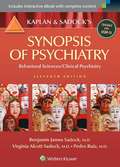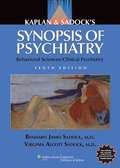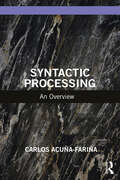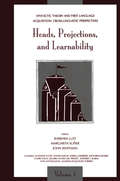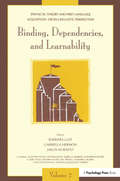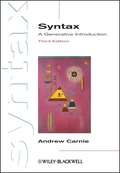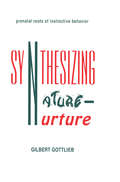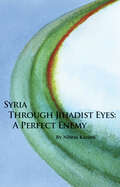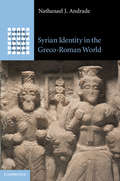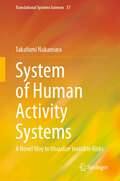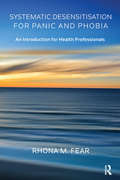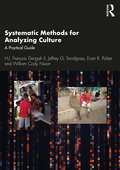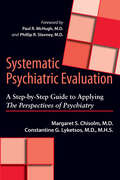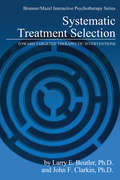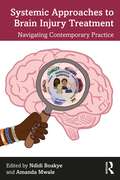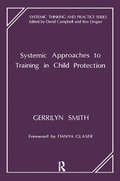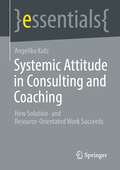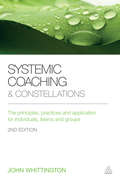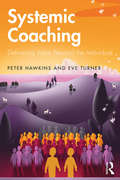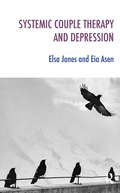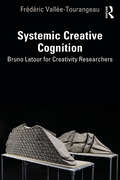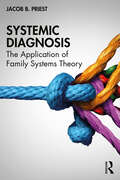- Table View
- List View
Synesthesia: A Union of the Senses
by Richard E. CytowicA detailed study of synesthesia, an involuntary joining of the senses in which information from one sense joins a perception from another
Synopsis Of Psychiatry: Behavioral Sciences/Clinical Psychiatry
by Pedro Ruiz Virginia A. Sadock Benjamin James SadockThe new and thoroughly updated 11th edition of Kaplan and Sadock's Synopsis of Psychiatry: Behavioral Sciences/Clinical Psychiatry is a complete overview of the entire field of psychiatry for clinicians, residents, students, and all others who provide mental health care. In this best-selling textbook in psychiatry for over 40 years, the reader will find a thorough discussion of both the behavioral sciences and clinical psychiatry. The 11th edition integrates all the DSM-5 criteria and provides a detailed and comprehensive overview of treatment methods for every known mental disorder. The 11th edition is set apart from any other reference you have and includes: DSM-5 diagnostic tables on every major psychiatric disorder. A psychopharmacology section organized according to mechanisms of action and updated to include all of the new drugs including those in preparation. Extensive use of case studies and illustrations to enhance the learning experience. The most current treatment methods including a description of all newly introduced psychotherapeutic techniques. A completely revised section on neurocognitive disorders organized along the DSM-5 model. An updated and expanded section on child psychiatry; now includes a guide to diagnosis and treatment of autism spectrum disorder and other disorders of childhood. A fully searchable eBook, bundled with the print. This publication is included on the ANCC: American Nurses Credentialing Center's reference list. The Synopsis of Psychiatry has been the leading clinical psychiatric resource for psychiatrists both in the US and around the world. It has the reputation of being an independent, accurate, reliable and objective compendium of new events in the field of psychiatry. Now in its 11th edition, the tradition continues, both in print and digital formats--from the authorities you can trust.
Synopsis of Psychiatry: Behavioral Sciences/Clinical Psychiatry (Tenth Edition)
by Benjamin J. Sadock Virginia A. SadockThe best-selling general psychiatry text since 1972, Kaplan and Sadock's Synopsis of Psychiatry is now in its thoroughly updated Tenth Edition. This complete, concise overview of the entire field of psychiatry is a staple board review text for psychiatry residents and is popular with a broad range of students in medicine, clinical psychology, social work, nursing, and occupational therapy, as well as practitioners in all these areas. The book is DSM-IV-TR compatible and replete with case studies and tables, including ICD-10 diagnostic coding tables. You will also receive access to the complete, fully searchable online text, an online test bank of approximately 100 multiple-choice questions and full answers, and an online image bank.
Syntactic Islands
by Cedric BoeckxThe phenomenon of the syntactic 'island' – a clause or structure from which a word cannot be moved – is central to research and study in syntactic theory. This book provides a comprehensive overview of syntactic islands. What are they? How do they arise? Why do they exist? Cedric Boeckx discusses the pros and cons of all the major generative accounts of island effects, and focuses the discussion on whether islands are narrowly syntactic effects, are due to interface factors or are 'merely' performance effects. Thanks to the diversity of island effects, readers are given a unique opportunity to familiarize themselves with all the major research styles and types of analysis in theoretical linguistics and have the chance to reflect on the theoretical implications of concrete natural language examples, allowing them to develop their own synthesis.
Syntactic Processing: An Overview
by Carlos Acuña-FariñaThis book provides an overview of the structures, topics and main theories of syntactic processing. It covers the last 40 years of sentence-level psycholinguistic research and debates and makes it accessible to both theoretical linguists and experimental psychologists. Tying linguistically relevant issues to psycholinguistic theory, this book: Covers the processing of the grammatical phenomena adjunction, agreement and gap filling and discusses the relationship between grammars and parsers Discusses experimental work and theories, demonstrating how psychologists have made real strides in understanding language and how studying the processing of syntactic structure is the same as studying the nature of language Explores the key theories of psycholinguistics, including recent developments Explains the different methodologies of sentence processing, such as eye-tracking and electroencephalography Bridging the gap between psycholinguistic research and the study of language, this book is essential reading for advanced students and scholars of linguistics and experimental psycholinguistics as well as cognitive science and psychology.
Syntactic Theory and First Language Acquisition: Cross-linguistic Perspectives -- Volume 1: Heads, Projections, and Learnability -- Volume 2: Binding, Dependencies, and Learnability
by John Whitman Claire Foley Suzanne Flynn Barbara Lust Margarita Suñer Shyam Kapur Isabella Barbier Katharina Boser Zelmira Nuñez del Prado Edward J. Rubin Lynn Santelmann Almeida Jacqueline ToribioUniversal Grammar (UG) is a theory of both the fundamental principles for all possible languages and the language faculty in the "initial state" of the human organism. These two volumes approach the study of UG by joint, tightly linked studies of both linguistic theory and human competence for language acquisition. In particular, the volumes collect comparable studies across a number of different languages, carefully analyzed by a wide range of international scholars. The issues surrounding cross-linguistic variation in "Heads, Projections, and Learnability" (Volume 1) and in "Binding, Dependencies, and Learnability" (Volume 2) are arguably the most fundamental in UG. How can principles of grammar be learned by general learning theory? What is biologically programmed in the human species in order to guarantee their learnability? What is the true linguistic representation for these areas of language knowledge? What universals exist across languages? The two volumes summarize the most critical current proposals in each area, and offer both theoretical and empirical evidence bearing on them. Research on first language acquisition and formal learnability theory is placed at the center of debates relative to linguistic theory in each area. The convergence of research across several different disciplines -- linguistics, developmental psychology, and computer science -- represented in these volumes provides a paradigm example of cognitive science.
Syntactic Theory and First Language Acquisition: Cross-linguistic Perspectives -- Volume 1: Heads, Projections, and Learnability -- Volume 2: Binding, Dependencies, and Learnability
by Claire Foley Suzanne Flynn Jaklin Kornfilt Barbara Lust Shyam Kapur Isabella Barbier Katharina Boser Zelmira Nuñez del Prado Edward J. Rubin Lynn Santelmann Gabriella Hermon Jacqueline ToribioUniversal Grammar (UG) is a theory of both the fundamental principles for all possible languages and the language faculty in the "initial state" of the human organism. These two volumes approach the study of UG by joint, tightly linked studies of both linguistic theory and human competence for language acquisition. In particular, the volumes collect comparable studies across a number of different languages, carefully analyzed by a wide range of international scholars. The issues surrounding cross-linguistic variation in "Heads, Projections, and Learnability" (Volume 1) and in "Binding, Dependencies, and Learnability" (Volume 2) are arguably the most fundamental in UG. How can principles of grammar be learned by general learning theory? What is biologically programmed in the human species in order to guarantee their learnability? What is the true linguistic representation for these areas of language knowledge? What universals exist across languages? The two volumes summarize the most critical current proposals in each area, and offer both theoretical and empirical evidence bearing on them. Research on first language acquisition and formal learnability theory is placed at the center of debates relative to linguistic theory in each area. The convergence of research across several different disciplines -- linguistics, developmental psychology, and computer science -- represented in these volumes provides a paradigm example of cognitive science.
Syntax
by Robert FreidinSyntax: Basic Concepts and Applications provides a systematic introduction to core topics in syntax, focusing on how the basic concepts apply in the analysis of sentences. Assuming no background in linguistic analysis, the book gives students a working knowledge of syntactic analysis from a minimalist perspective. Step by step it explains the fundamentals of phrase structure, movement and deletion. Well-placed exercises throughout reinforce and extend the concepts and analyses presented in the text, allowing readers to gain understanding of progressively complex issues at a comfortable pace. Much of the data comes from English, but crucial examples are also drawn from a range of other languages, including Russian, Chinese, Japanese, French, Italian, Spanish, Irish, Welsh and Greek.
Syntax: A Generative Introduction
by Andrew CarnieAndrew Carnie's bestselling textbook on syntax has guided thousands of students through the discipline of theoretical syntax; retaining its popularity due to its combination of straightforward language, comprehensive coverage, and numerous exercises.
Synthesizing Nature-nurture: Prenatal Roots of Instinctive Behavior (Distinguished Lecture Series)
by Gilbert GottliebThis volume provides a primarily nontechnical summary of experimental and theoretical work conducted over the course of 35 years which resulted in a developmental framework capable of integrating causal influences at the genetic, neural, behavioral, and ecological levels of analysis. It describes novel solutions to the nature-nurture problem at both the empirical and theoretical levels. Following field observations, laboratory experiments led to the discovery of the nonobvious prenatal experiential basis of instinctive behavior in two species--ground-nesting mallard ducklings and hole-nesting wood ducklings. This work also describes the experiences that lead to the rigid canalization of behavioral development as well as the social and sensory experiences that favor the continuance of flexibility. The author also describes in detail a developmental psychobiological systems view that supports a behaviorally and psychologically mediated pathway to evolutionary change in humans and other species. Written in a way that is readable to even the nonspecialist, the text is accompanied by numerous photographs that illuminate and add personal meaning to the written words. Readers will be engaged by the emphasis on the human aspect of the scientific enterprise.
Syria through Jihadist Eyes: A Perfect Enemy
by Nibras KazimiWith field notes accumulated in a Syrian environment not generally hospitable to research and inquiry, Nibras Kazimi provides a unique view of the Syrian regime and its base at home, filling a void in our understanding of the intelligence barons and soldiers who run that country. He offers a look at the tactical, propagandists and strategic ingredients required, in jihadist eyes, for a successful jihad—and whether those ingredients are available in Syria.
Syrian identity in the Greco-Roman world (Greek Culture In The Roman World Ser.)
by Nathanael J. AndradeBy engaging with recent developments in the study of empires, this book examines how inhabitants of Roman imperial Syria reinvented expressions and experiences of Greek, Roman and Syrian identification. It demonstrates how the organization of Greek communities and a peer polity network extending citizenship to ethnic Syrians generated new semiotic frameworks for the performance of Greekness and Syrianness. Within these, Syria's inhabitants reoriented and interwove idioms of diverse cultural origins, including those from the Near East, to express Greek, Roman and Syrian identifications in innovative and complex ways. While exploring a vast array of written and material sources, the book thus posits that Greekness and Syrianness were constantly shifting and transforming categories, and it critiques many assumptions that govern how scholars of antiquity often conceive of Roman imperial Greek identity, ethnicity and culture in the Roman Near East, and processes of 'hybridity' or similar concepts.
System of Human Activity Systems: A Novel Way to Visualize Invisible Risks (Translational Systems Sciences #37)
by Takafumi NakamuraThis book has unique features that set it apart from conventional books on the prevention of system failures in that it provides a method that views human activities from a meta-methodological perspective based upon an inter-disciplinary understanding of human activities. With these characteristics, the book also proposes a common methodological basis to apply to various problems surrounding society today such as an aging social infrastructure; the safety of food, medicine, and public transportation; and the creation of sustainable electricity and cybersecurity. Furthermore, since the failure of human activities is expressed in a three-dimensional space and the topological metrics are implemented, the failure trajectories can be quantitatively monitored in time series to take effective preventive measures. Considering the implementation of the topological metrics, the causes of each failure are classified into two dimensions of the degree of coupling between system elements and the interaction between the target system and the external environment. Owing to the nature of the introduction of topological metrics, all individual and diverse systems can share general topological metrics. Consequently, understanding various failures over cross-industries is possible with the use of common meta-systemic language and mutual learning between different industries, and the solution of social problems can be effectively achieved. A system of system failures (SOSF) proposed and confirmed the effectiveness of this meta-methodology for information and communication technologies (ICT) systems and the SOSF is extended to human activity systems (SOHAS: system of human activity systems) as a whole. Therefore, the SOHAS becomes an academic foundation for theoretical research on meta-methodology, and it has an impact on practitioners to prevent system failures by accumulating knowledge of failures and learning from other industries.
Systematic Desensitisation for Panic and Phobia: An Introduction for Health Professionals
by Rhona M. FearPanic disorder and phobia are difficulties that are commonly encountered in our consulting rooms. There is an ongoing debate concerning the lack of provision within the NHS to help those with mental health problems. This book puts forward a different method of recovery called systematic desensitisation, which is rarely covered by the many books that are available on the subject. Rhona M. Fear presents this method both as a former patient and as a therapist of almost thirty years' standing. It can be learned and used highly successfully by practitioners to help alleviate panic disorder and phobia.
Systematic Methods for Analyzing Culture: A Practical Guide
by H.J. François Dengah II Jeffrey G. Snodgrass Evan R. Polzer William Cody NixonSystematic Methods for Analyzing Culture is a practical manual that provides step-by-step instruction for collecting and analyzing cultural data. This compact guide explains complex topics in straightforward and practical terms, via research examples, textual and visual software guides, and hands-on exercises. Through each chapter’s introductory examples, the manual illustrates how socially learned knowledge provides group members with shared understandings of the world, which allow for mutually intelligible interactions. The authors then carefully walk readers through the process of eliciting those socially learned, shared, and thus cultural representations of reality, which structure the thinking and practice of individuals inhabiting social groups. Specifically, the book shows how researchers can elicit such thought and behavior via methods such as free lists, pile sorts, cultural consensus and consonance analysis, textual analysis, and personal network research. The book will help both undergraduate and graduate students identify ways to unpack the "black box" of culture, which may be absent or given only cursory attention within their training and respective fields. The book’s clear and systematic step-by-step walkthroughs of each method will also encourage more established researchers, educators, and practitioners—from diverse fields and with varying levels of experience—to integrate techniques for assessing cultural processes into their research, teaching, and practice.
Systematic Psychiatric Evaluation: A Step-by-Step Guide to Applying The Perspectives of Psychiatry
by Margaret S. Chisolm Constantine G. LyketsosTwo Johns Hopkins psychiatrists explain the Perspectives approach to evaluating patients with psychiatric disorders.The Perspectives approach to psychiatry focuses on four aspects of psychiatric practice and research: disease, dimensional, behavior, and lifestory. In Systematic Psychiatric Evaluation, Drs. Margaret S. Chisolm and Constantine G. Lyketsos underscore the benefits of this approach, showing how it improves clinicians' abilities to evaluate, diagnose, and treat patients.Drs. Chisolm and Lyketsos use increasingly complex case histories to help the mental health provider evaluate patients demonstrating symptoms of bipolar disorder, psychosis, suicidal ideation, depression, eating disorders, and cutting, among other conditions. The book also includes an exercise that simulates the Perspectives approach side by side with traditional methods, revealing the advantages of a method that engages not one but four points of view. Featuring a foreword by Drs. Paul R. McHugh and Phillip R. Slavney, the originators of the Perspectives approach, this innovative book will be used in psychiatric training programs as well as by practicing mental health clinicians.
Systematic Treatment Selection: Toward Targeted Therapeutic Interventions
by Larry E. Beutler John F. ClarkinFirst published in 1990. Routledge is an imprint of Taylor & Francis, an informa company.
Systemic Approaches to Brain Injury Treatment: Navigating Contemporary Practice
by Amanda Mwale Ndidi BoakyeThis book is an exploration of key systemic and socio-political considerations when working with people whose lives have been impacted by neurological injury and those who care for them. Expert contributors consider the impact of intersectionality across domains that include gender, sexuality, class, education, religion and spirituality, race, culture, and ability/disability. It offers relevant literature in the field of neuropsychology as well as clinical case studies that provide inspiration and key reflections for clinicians, neurological specialist therapists, and medical staff alike. Chapters discuss navigating intersectionality in couple therapy, hidden social inequalities in paediatric neurorehabilitation, racial microaggression in inpatient settings, and more. This book is essential for all health and social-care practitioners working in the field of brain injury and chronic illness who want to challenge the status quo and advocate for diversity and inclusion.
Systemic Approaches to Training in Child Protection: Systemic Approaches To Training In Child Protection (The Systemic Thinking and Practice Series)
by Gerrilyn SmithThis book contributes to the scientific and ideological debate on child sexual abuse and illuminates the trainer practitioner in the process by recognizing that human services training is built on the ideology and values of the sponsoring organisation, the participants, and the trainer.
Systemic Attitude in Consulting and Coaching: How Solution- and Resource-orientated Work Succeeds (essentials)
by Angelika KutzIn this Springer essentials it is shown that the action portfolio of systemics offers a wonderful basis to support clients - or a client system - in the best possible way to initiate and shape change processes (change) and to work out suitable solutions for the client system. The systemic attitude can also be learned, is a healing companion in all life situations and represents a continuous maturing process.
Systemic Coaching and Constellations
by John WhittingtonSystemic Coaching and Constellations offers a refreshingly uncomplicated path into a potentially complex subject, demonstrating how this approach can provide access to systems and deliver enduring benefits for coaching clients. This new edition offers a comprehensive introduction to the principles that sustain systems, real world descriptions of what systemic coaching is and how it can be useful as well as a step-by-step guide to integrating the principles and practices into coaching. Highly practical, Systemic Coaching and Constellations includes a wide range of exercises for application with individuals and teams. It also includes a brand new chapter on Belonging, fully updated case studies from coaches who have taken part in John's trainings, a joint ICF/EMCC constellation workshop and examples from coaches around the world, including Australia, Mexico, France, Spain, US and the Netherlands. Whether used in an initial selection meeting or to underpin all your coaching conversations and interventions, Systemic Coaching and Constellations offers an accessible, practical starting point to transform your coaching practice.
Systemic Coaching: Delivering Value Beyond the Individual
by Peter Hawkins Eve TurnerHawkins and Turner argue that coaching needs to step up to deliver value to all the stakeholders of the coachee, including those they lead, colleagues, investors, customers, partners, their local community and also the wider ecology. Systemic Coaching contains key chapters on how to contract in various settings, how to work relationally and dialogically, how to expand our own and others’ ecological awareness, how to get greater value from supervision, work with systemic ethics and expand our impact. While illustating why a new model of coaching is necessary, Hawkins and Turner also provide the tools and approaches that coaches and clients need to deliver this greater impact, accompanied by real-life case examples and interviews from the authors and other leading coaches and leaders globally. Systemic Coaching will be an invaluable resource for coaches in practice and in training, mentors, coach supervisors, consultants in leadership development and HR and L&D professionals and leaders.
Systemic Couple Therapy and Depression (The Systemic Thinking and Practice Series)
by Eia Asen Elsa JonesBased on a research project which demonstrated the effectiveness of systemic therapy, this book can be used as the basis of a training programme in systemic couple therapy, as a phase in the treatment of depression. It describes in explicit detail the range of techniques used and can therefore also inform the next generation of research studies, which will be greatly facilitated by this work.
Systemic Creative Cognition: Bruno Latour for Creativity Researchers
by Frédéric Vallée-TourangeauThis unique book explores how the conceptual framework of science and technology studies can be applied to creativity and problem-solving research, drawing from and building on the work of Bruno Latour. Using an interdisciplinary approach, the book outlines new research practices to capture the origin of ideas. Latour enjoins researchers to adopt a resolutely ethnographic methodology to trace the process by which a creative product, be it a technological innovation or a work of art, is constructed, or instaured. Creativity is explained in terms of the microprocesses that guide and constrain the development of a new idea. These microprocesses operate on and are triggered by material objects, be they maquettes, models, drafts or data representations. The resulting perspective is systemic, casting creativity as emerging from the interaction among heterogenous elements and actants. The book provides critical reflections on problem-solving research and stresses the importance of William James’s radical empiricism and the primary role of experience. The book redefines the concept of insight as an outcome rather than the cause of a new idea. The book uses the work of Latour to cast a new light on the field of creative cognition and will be an essential read for researchers and students of creativity and cognition. It will also be relevant for anyone interested in understanding the origin of creativity, ideas and thoughts.
Systemic Diagnosis: The Application of Family Systems Theory
by Jacob B. PriestSystemic Diagnosis: An Application of Family Systems Theory helps marriage and family therapists incorporate theory-driven assessment and diagnosis into their practice, demonstrating how they can diagnose systems, not just individuals. This introductory textbook argues that theory and diagnosis are key to providing excellent care in family therapy. Rooted in family systems theory, Jacob B. Priest offers readers a model to diagnosis the history, structure, and boundaries of family systems. Chapters begin by looking at traditional and relational models of diagnosis before diving into systemic diagnosis. Readers are introduced to the EPIC assessment and guided on how to use it in their practice. Filled with case studies throughout, the book also includes digital content so students can practice a diagnosis process rooted in family systems theory. Designed to be used on COAMFTE accredited programs, this book is essential for couple and family therapy students who are taking courses in assessment and mental health diagnosis and treatment.

